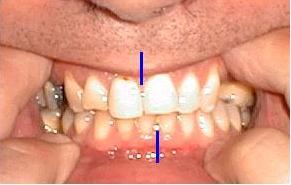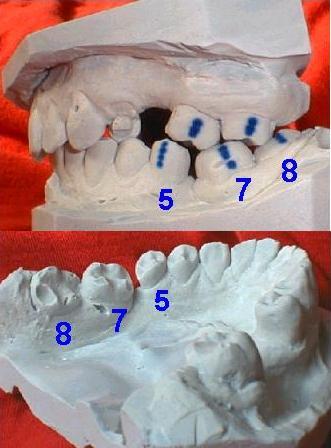WILDWEST mit
festen Spangen
NO ESCAPE, if fixed braces
are handled improperly?
 Diese
windschiefe Gebiss-Situation besteht nicht etwa VOR, sondern
einige Jahre NACH dem Ausbau einer festen Spange.
Diese
windschiefe Gebiss-Situation besteht nicht etwa VOR, sondern
einige Jahre NACH dem Ausbau einer festen Spange.
Sie ist das
Ergebnis eines gewaltsamen Versuches, einen unteren 7er an den Platz
eines früher gezogenen 6ers zu zerren.
Dafür sind auch
die deutlich geschwollenen Zahnfleischsäume der stark gekippten,
an die Lücke grenzenden Zähne ein Indiz. Eine spätere
spontane Kippung in die (Rest-)Lücke, wie sie bei Leuten mit
„wanderungsfreudigen“ Zähnen vorkommt, hätte das
Zahnfleisch nicht derart verändert.
Ein kieferorthopädischer
6er-Lückenschluss ist zugegeben keine leichte Aufgabe, aber
hätte eine Versorgung der Lücke mit Zahnersatz stattdessen,
und ggf. zusätzlich kleinere Maßnahmen zur
Frontzahn-Korrektur, nicht fast die ganze übrige
Gebiss-Situation geschont?
Nun stehen nicht nur die Hochachsen der
2 oberen und unteren Mahlzähne auf dieser Seite schief, sondern
sie sind auch in Längsrichtung nicht richtig verzahnt!
Die
obere 5er-Lücke hat volle Größe, der angrenzende
Mahlzahn ist stark vorgekippt.
Angeblich wurden für die
Spange Zähne gezogen – man fragt sich, welche?
Der
untere Weisheitszahn (8) ist offenbar später erschienen, ist
aber um 2 Achsen um ca. 45° verkippt (siehe die Innenansicht) und
hat keinen Gegenpart im Oberkiefer, ist zum Kauen also nutzlos.
Somit
ist die nutzbare Kaufläche auf dieser Seite auf etwa 40%
reduziert! Der abgebrochene 4er ist mit einer Krone oder Brücke
zu versehen.
This
mismatched bite is presented by no means BEFORE, but some years AFTER
treatment with fixed braces. It is the result of a forced attempt to
drag a lower molar 7 forward into the full gap of a lacking molar
6.
Note the swollen gums around the severely tilted teeth on both
sides of the residual gap. These still indicate that high force was
applied, rather than that a later, spontaneous tilting into the gap
has occurred, which can happen in patients with very „mobile“
teeth.
Honestly
spoken, orthodontic closure of a molar gap is a difficult task, but
wouldn´t a prosthetic closure of this gap, and if desired, an
additional „small“ correction of the incisors, have left
the rest of the dentiton in a healthier state?
 Now,
not only the vertical axes of the 2 upper and 2 lower molars on this
side are markedly tilted. Moreover, also the matching of their upper
and lower positions id poor.
Now,
not only the vertical axes of the 2 upper and 2 lower molars on this
side are markedly tilted. Moreover, also the matching of their upper
and lower positions id poor.
The upper gap has full size, the
adjacent molar is inclined forward. The patient said that teeth had
been extraced for his braces – but which ones?
The lower
wisdom tooth (8) seemed to have appeared later. But since it is
tilted around 2 axes by 45° each, and has no upper counterpart,
it is of no use for chewing. In total, the usable chewing area is
reduced to 40% on this side! A crown or bridge will be required for
tooth 4 which recently broke off.
Frontal sind die Mittellinien der
Zahnreihen um etwa 3mm zueinander verzogen worden! Die
Unterkiefer-Zähne wurden von den Schneidezähnen an so weit
herüber in die 6er-Lücke gezerrt. Der untere Eckzahn steht
dort glatt unter dem oberen, statt 1/2 Breite weiter vorn.
Auf der Gegenseite ist die Verzahnung
trotz leicht vorgekipptem unteren 7er normal. Aber da der obere 4er
über der Wurzel abgebrochen ist, der untere 6er offenbar später
gezogen wurde (unvermindert große Lücke) und die
Weisheitszähne fehlen, ist auch auf dieser maroden Seite die
nutzbare Kaufläche auf 40% reduziert!
Der Patient beklagte
sich vor allem darüber, dass Drahtelemente seiner
Retentionsspangen vorzeitig abgekniffen wurden, so dass sich die
Schneidezähne wieder ein Stück aus der Reihe
zurückbewegten.
Sollte
man sich als Patient nicht lieber VORHER fragen, wie man glimpflich
aus so einer Behandlung herauskäme, falls sich in ihrem Verlauf
abzeichnen sollte, dass sie nicht so glatt läuft wie in der
Werbung der Praxen und der Hersteller?
Und was es für
Alternativen gäbe, und wie deren Risiken wären? Weitere
Meinungen einholen ist nie verkehrt.
In
frontal view, the treatment had shifted the midlines of the arches by
3 mm! All lower teeth, beginning from the incisors, were dragged in
direction of the large gap. The lower cuspid stands just underneath
the upper one, instead of a correct half of its width more forward.
The
teeth on the other side match normally, even with the lower 7
slightly inclined forward. But since the upper 4 broke off just above
its root, and the lower 6 was apparently extracted later (its gap has
full size) and no wisdom teeth have appeared, the usable chewing area
is reduced to 40% on this side either!
The patient complained
mainly that elements of his retainers had been cut off before
complete retention was achieved, so that his incisors moved back part
of the way to their old positions.
Should
one better imagine BEFORE beginning such a kind of treatment, how to
get out it if it starts to go wrong, and not proceeds smoothly as in
the publicity of the doctors and the suppliers? Shouldn´t one
check first which alternatives would exist, and how their own risks
would be? Anyway, it is never wrong to obtain a second opinion.
Letztes
Update dieses Kapitels +++ last
update: 22.10.2005
HOME
 Diese
windschiefe Gebiss-Situation besteht nicht etwa VOR, sondern
einige Jahre NACH dem Ausbau einer festen Spange.
Diese
windschiefe Gebiss-Situation besteht nicht etwa VOR, sondern
einige Jahre NACH dem Ausbau einer festen Spange. Now,
not only the vertical axes of the 2 upper and 2 lower molars on this
side are markedly tilted. Moreover, also the matching of their upper
and lower positions id poor.
Now,
not only the vertical axes of the 2 upper and 2 lower molars on this
side are markedly tilted. Moreover, also the matching of their upper
and lower positions id poor.